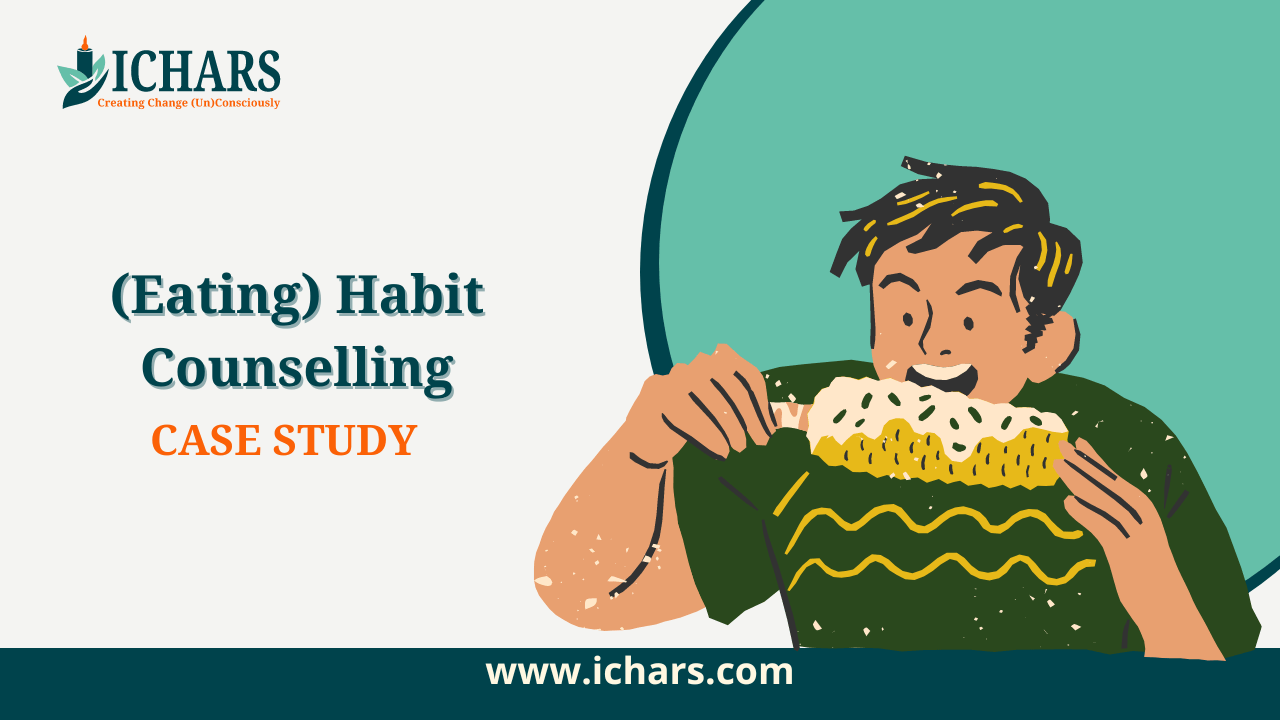I recently had the privilege of speaking with Payal (name changed), who reached out to me seeking assistance in her journey to change her eating habits. Payal expressed her frustration, as she had exhausted numerous attempts but found herself unable to overcome the shame associated with certain food items, among other challenges.
Upon our initial phone conversation, it became clear that Payal was seeking a solution that would address her concerns effectively. Recognising the importance of providing tailored support, we promptly arranged an online consultation session.
Habit Counselling Case Study – Complete Session Flow
Initial Consultation/ Pre-Therapy Session
During our initial session, Payal delved into the details of the challenges she had previously mentioned over the phone.
She shared her ongoing struggle with managing her weight, describing her attempts at incorporating an exercise regimen and altering her eating habits. Despite her efforts, Payal found it difficult to sustain these changes, leading to feelings of frustration and disappointment.
One recurring issue Payal faced was her struggle with guilt and shame surrounding certain food choices. Although she had been advised that occasional indulgences were acceptable, she still found herself feeling remorseful after consuming such foods. This prompted her to conceal her eating habits, adding to her emotional burden.

Furthermore, Payal admitted to occasionally skipping meals or resorting to unhealthy options due to time constraints. This further contributed to her self-judgment and skepticism about her ability to maintain healthier eating patterns.
As she shared her experiences, Payal revealed that her childhood had been marked by being overweight and enduring bullying at school. The echoes of her parents’ admonitions to eat mindfully and properly resurfaced, intensifying her present struggles with improving her eating habits as an adult.
Understanding the gravity of Payal’s concerns, I began by providing her with a psycho-educational overview of the therapeutic approach I employ – Cognitive Hypnotic Psychotherapy.
This comprehensive method combines various techniques within psychotherapy, making it particularly effective for habit counseling and addressing trauma responses. I then guided Payal through the pre-counseling process, ensuring she had a clear understanding of the therapy’s structure and goals.
Steps by Step Process
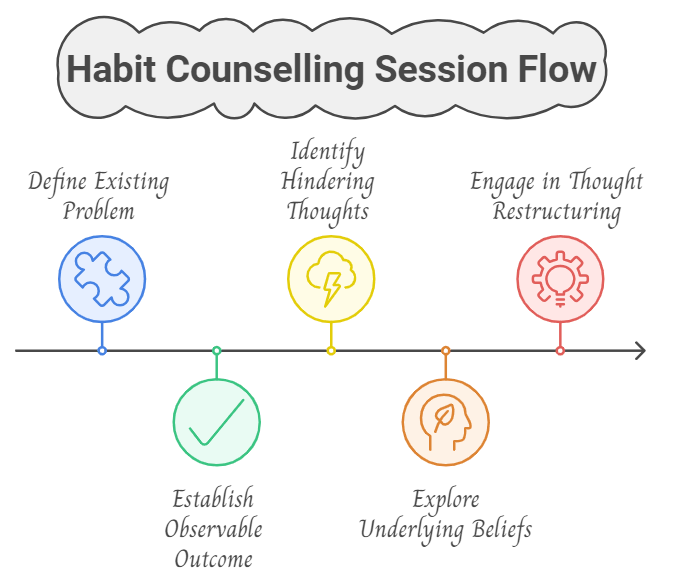
In Payal’s specific case, I outlined the steps we would take together to overcome her challenges. These steps included:
- Clearly defining the existing problem, ensuring a thorough understanding of its nature and impact.
- Establishing a concrete and observable outcome for our sessions, setting the stage for measurable progress.
- Identifying the thoughts and emotions that hinder the development of new, healthier habits.
- Exploring any underlying beliefs or secondary gains associated with her previous eating habits, uncovering potential obstacles to change.
- Engaging in thought restructuring and belief realignment, alongside reconditioning associated emotions, to foster lasting transformation.
By outlining this personalized approach, I aimed to instill hope and confidence in Payal, assuring her that we would address her concerns comprehensively and assist her in achieving sustainable positive change.
Session 1: Defining Challenge and Desired Outcome
During the first session of Habit Counselling, our focus was on assisting Payal in defining her current situation, desired outcome, and anticipated future using the Soft Seas framework.
Meta Model questioning helped in removing generalization, distortion, deletion, and helping define the problem without ambiguity.
To initiate the session, I requested that Payal provide a concise summary of the challenge she was facing and wished to address through our therapeutic process. Payal expressed her feelings of anxiety and overwhelm regarding her eating habits, particularly her struggle to maintain a consistent routine despite her initial motivation.
Next, I guided Payal in reframing her problem statement using the following format:
“I feel [emotion] about [specific situation] when [trigger].” Payal articulated her reframed statement as follows:
“I feel overwhelmed about my eating habits when I cannot follow the schedule.”
This exercise allowed us to pinpoint the core emotions and circumstances that needed to be addressed for effective progress.
To further clarify her objectives, I prompted Payal to state her desired outcome in the format: “I wish [desired outcome].”
Payal shared her aspiration: “I wish to follow my new eating regime confidently and efficiently.”
This clear articulation of her goal provided a concrete target for our sessions.
In order to delve deeper into the benefits of adhering to the new routine and the challenges she faced when unable to do so, I instructed Payal to create a list for each category.
By identifying the advantages she would experience by successfully following the new regimen and acknowledging the problems that arose from her current struggles, Payal gained greater insight into the significance of change and the potential obstacles to overcome.
Lastly, I assigned Payal a meaningful homework task. I requested that she envision and document how her life would be different once she had successfully achieved her goal.
I encouraged her to vividly describe the sensory experiences she would encounter – what she would hear, see, and feel – once she had attained her desired outcome. This exercise aimed to strengthen her motivation and provide a tangible vision of the positive transformation she sought.
By engaging Payal in this structured process of self-reflection and goal-setting, I aimed to empower her with a clearer understanding of her challenges, desired outcome, and the potential rewards that awaited her.
Session 2: Identifying the thoughts and emotions acting as a barrier in inculcating the new habit.
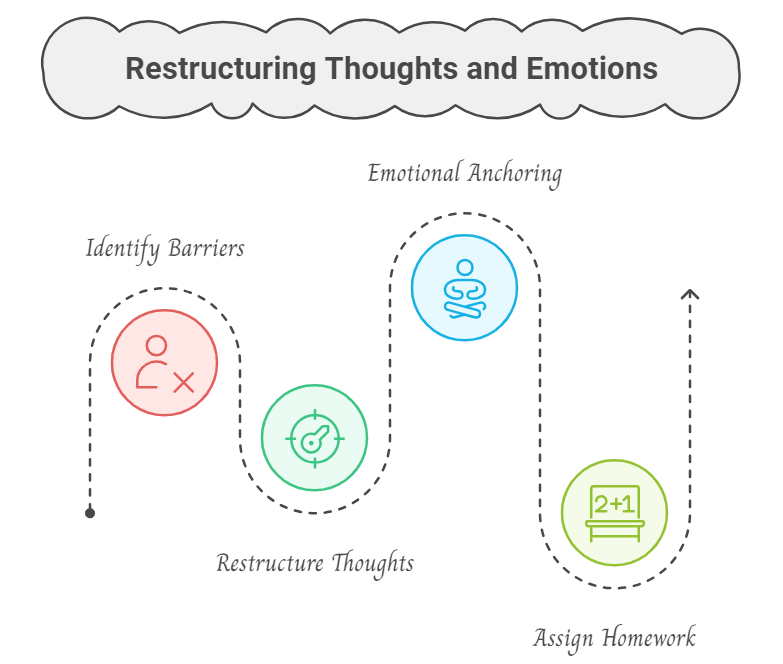
In our subsequent session, we began by reviewing the progress we had made during the previous session. After discussing and reflecting upon Payal’s completed homework assignment, I directed our focus towards identifying the specific thoughts that hindered her adherence to the new routine and triggered feelings of guilt regarding certain food items.
To gain a comprehensive understanding of Payal’s thought patterns, I asked her to articulate the exact thoughts that acted as barriers to following the new routine and those that induced guilt. Furthermore, I inquired about the specific circumstances or triggers that precipitated her feelings of anxiety and guilt.
Payal mentioned that she often experienced these emotions when encountering health transformation videos on Instagram. She described her thoughts during those moments, stating, “I am a disappointment that I cannot lose weight.”
Giving it a formate and summarising it:
“When I see health transformation videos on Instagram, then I feel disappointed that I cannot loose weight.”
Following this exploration, I prompted Payal to envision the desired thought and emotion that would propel her towards her goal.
She expressed that the thought she aspired to adopt was “I am consciously and consistently working on myself,” while the desired emotion was “proud.” With this clarified objective, we proceeded to engage in thought restructuring exercises, aiming to transform negative thought patterns into more empowering and supportive ones.
“When I see health transformation videos on Instagram, then I feel proud that I am consciously and consistently working on myself .”
Next, I encouraged Payal to identify an emotion that she believed would be beneficial in the aforementioned situations. She expressed her desire to cultivate a sense of calmness.
Leveraging the technique of emotional anchoring, I guided Payal in developing an association between the experience of calmness and the moments when she followed the new routine or tried different food items. This anchoring process aimed to help her access a state of calmness during those crucial moments, facilitating her progress towards her goals.
For Payal’s homework assignment, I assigned her the task of repeating the restructured thought, to herself consistently throughout the week. This repetition would reinforce the positive thought pattern, supporting her in maintaining motivation and focus on her journey.
“When I see health transformation videos on Instagram, then I feel proud that I am consciously and consistently working on myself .”
By engaging in these therapeutic exercises and homework assignments, Payal would be equipped with valuable tools to counter unhelpful thoughts and cultivate a sense of pride and calmness as she pursued her desired changes in eating habits.
Session 3: Working with Secondary Gains
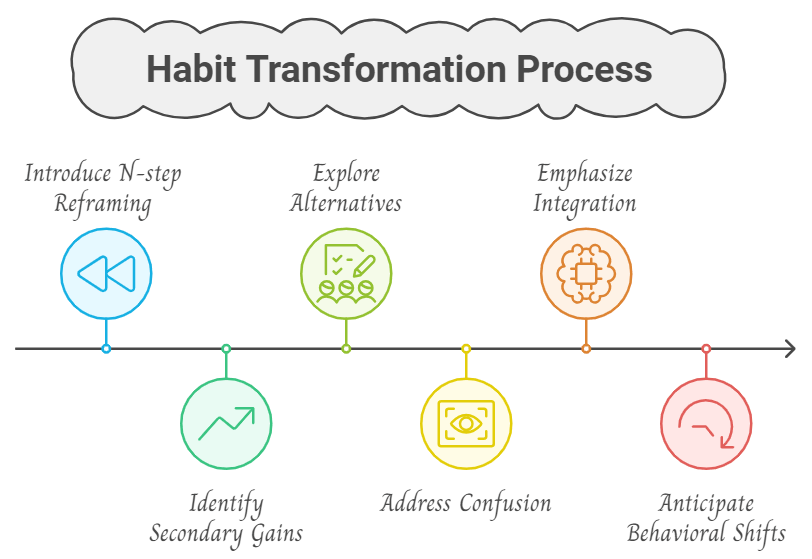
During this session, we began by reviewing the progress Payal had made over the past week. Payal shared that she had made some strides in following the new regimen, although she expressed a desire for more consistency in her efforts.
To address this challenge, we employed the N-step reframing process. This technique allowed us to identify any secondary gains Payal might be receiving from her current behaviour, which could be impeding her progress towards her desired goal.
By uncovering these secondary gains, we could explore alternative ways for Payal to fulfil those needs while still working towards her objective.
Following the reframing exercise, Payal appeared somewhat perplexed and expressed her uncertainty about understanding the alternate approaches we had discussed. I reassured her that this initial confusion was a natural response to the process.
I emphasised that her unconscious mind had already begun integrating the changes, and she would gradually start observing shifts in her behaviour over the coming days.
By acknowledging and addressing the potential secondary gains that may be influencing Payal’s behaviour, we paved the way for her to explore new avenues to fulfil those needs in a manner aligned with her goals. This approach would ultimately contribute to her progress and success in transforming her eating habits.
Session 4: Working with Past Experiences
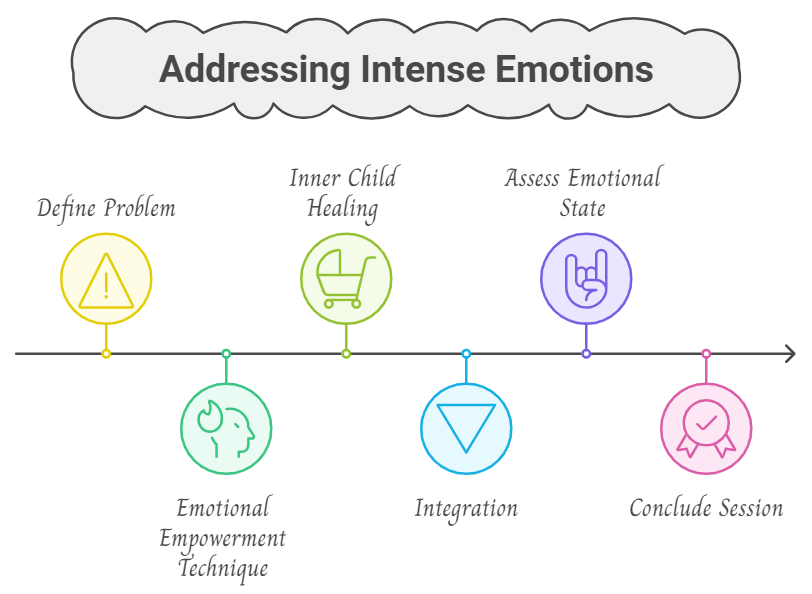
During this session, we began by reviewing the progress Payal had made over the past week. Payal shared that she had been able to adhere to the regimen more effectively and was already experiencing a positive shift in her overall well-being.
However, she also expressed lingering feelings of guilt on days when she took a break from the regimen, as well as self-judgment regarding her eating habits. Additionally, Payal had previously mentioned experiences from her childhood where she had felt shamed due to her weight.
With these factors in mind, the objective of today’s session was to explore if there were any secondary gains Payal was subconsciously seeking through her current behaviour. We also aimed to release any repressed or hidden emotions that might be contributing to her challenges.
To initiate this process, we began by defining Payal’s problem in a concise sentence. This provided clarity and focus as we embarked on the Emotional Empowerment technique, combined with Delayering. As we progressed through the session, Payal recalled a specific incident from her childhood that held emotional significance.
This prompted us to delve into the inner child healing process. I guided Payal to connect with the part of herself that was seeking secondary gain and facilitated a nurturing and supportive connection with her inner child. We reassured the child that she was loved, cared for, and protected. Payal was then guided to help the child release any negative emotions, creating a space of comfort and safety.
Following this, Payal was encouraged to envision the child growing to her current age and integrating with her present self.
Upon completion of the inner child healing process, I inquired about Payal’s emotional state. She expressed a deep sense of calmness and newfound confidence. Payal reported feeling light and conveyed a strong belief in her ability to continue with her new eating regime.
The session concluded with Payal experiencing a heightened sense of emotional well-being and a renewed sense of confidence. By addressing any underlying secondary gains and providing healing for her inner child, we laid the foundation for her continued success in maintaining the positive changes in her eating habits.
Session 5: Closure

During the previous session, Payal shared positive updates regarding her progress. She expressed feeling confident and actively integrating the new eating habits into her routine. Notably, she mentioned a significant shift in her mindset, no longer experiencing shame related to specific food items as she had before.
To further support Payal’s journey, we introduced the Ho’oponopono technique in our last session. This technique serves to release any lingering negative emotions that may be holding her back.
Payal engaged in the process, and afterwards, she expressed a profound sense of relief. She described feeling as though a heavy burden had been lifted from her shoulders. Payal also expressed surprise at the names that emerged during the process, indicating a deeper release and healing.
Helping Client become self dependent
Recognising the importance of ongoing self-care and empowerment, I introduced Payal to the practice of self-hypnosis. This technique equips Payal with a valuable tool for addressing any future concerns or challenges that may arise on her journey. By teaching her self-hypnosis, Payal gains the ability to tap into her inner resources and navigate any obstacles that may come her way.
The combination of the Ho’oponopono technique and self-hypnosis empowers Payal with a comprehensive set of tools to maintain her progress, continue releasing any negative emotions, and cultivate resilience in the face of future challenges.
My Observations:
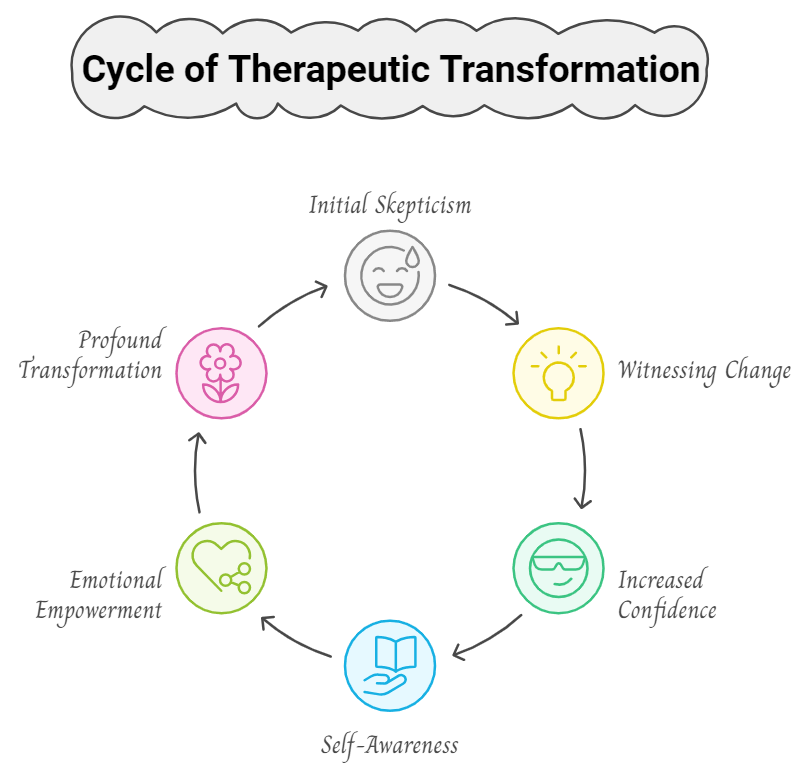
During my therapeutic sessions in habit counselling, I have observed a noteworthy pattern when implementing techniques such as N-step reframing. Clients may initially express unawareness or skepticism regarding their underlying issues.
However, as they witness tangible changes and transformations within themselves, their faith and confidence in the therapeutic process naturally strengthen.
Furthermore, by engaging in the Emotional Empowerment Technique (EET) with clients, they gain a heightened level of self-awareness. This process allows them to uncover repressed emotions and thoughts that they had assumed were resolved or long in the past.
EET serves as a valuable tool in helping clients recognize and address these previously unrecognized aspects of their experiences.
These observations emphasize the importance of a comprehensive therapeutic approach that encourages self-reflection, fosters awareness, and promotes healing. By incorporating techniques that facilitate this process, clients can experience profound transformations and develop a deeper understanding of themselves.
References of techniques used:
The techniques employed in this case study of (Eating) Habit Counselling draws from various methodologies, including :
- SOFT SEA Coaching Model
- Meta Model
- Thought Restructuring
- Emotional anchoring
- Inner Child Healing
- Ho’oponopono
- Self-hypnosis
These approaches have been integrated to create a comprehensive and effective therapeutic process.
The concepts and techniques discussed during this case study are based on the topics covered during the Cognitive Hypnotic Coaching® Diploma and the Cognitive Hypnotic Psychotherapy™ Diploma
By applying these evidence-based techniques and building upon a solid theoretical framework, counsellors can effectively support their clients’ progress and help them achieve their desired outcomes.
